
Falcondale House is a Grade II listed former country house, now the Falcondale Mansion Hotel, which is situated some 1 mile north-west of Lampeter, Ceredigion, in south west Wales. [1]

Falcondale House is a Grade II listed former country house, now the Falcondale Mansion Hotel, which is situated some 1 mile north-west of Lampeter, Ceredigion, in south west Wales. [1]
From the 1600s the Peterswell estate had been owned by the Evans and then the Lloyd families, but due to financial problems and absentee owners the house was left empty and became derelict. [2]
The estate was acquired in 1812 by Richard Hart-Davis, who planted several hundred thousand trees and possibly rebuilt the house. His daughter Louisa married John Scandrett Harford, author and art collector, and when Hart-Davis ran into financial difficulties, the estate passed to his son-in-law (and the latter's brother, Abraham Grey Harford-Battersby) in 1819 and subsequently to John Scandrett's nephew, John Battersby Harford. John Battersby commissioned architect Talbot Bury to redesign the house in an Italianate style in 1859 and lived there with his wife Charlotte de Bunsen, the daughter of Baron de Bunsen. On his death in 1875 the property passed to his son John Charles Harford, who, like his father, was appointed High Sheriff of Cardiganshire. He was created a baronet in 1934 but died soon afterwards. His eldest son, John Henry, had been killed at Thiepval during the First World War and so the property passed to his younger son, George Arthur, the second baronet. [2]
In 1951 the house was sold to Cardiganshire County Council for use as a retirement home and most of the land disposed of. Around 1975 the building was sold to H. L. Smith to be converted into a hotel. In July 1994 Stafford Beer gave a series of 9 talks at the hotel. They were recorded to provide a video learning resource which are collectively known as the Falcondale Collection. They are available online at the Data Repository of Liverpool John Moores University. [3] Since 2000 it has been owned and run as a hotel by Chris and Lisa Hutton. [2]
The coach house was built in the nineteenth century, probably in 1859, at the time the house was rebuilt. It consists of a yard with a two-storey coach house on one side flanked by single storey wings and is listed as being a fine example of estate buildings of the period. The coach house, North Lodge and Falcondale Home Farm are Grade II listed buildings. [4] [5] [6]
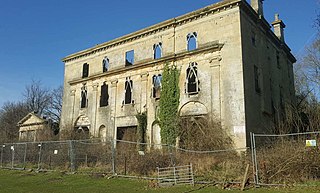
Piercefield House near St Arvans, Monmouthshire, Wales, about 1.5 miles (2.4 km) north of the centre of Chepstow, is a largely ruined neo-classical country house. The central block of the house was designed in the very late 18th century, by, or to the designs of, Sir John Soane. It is flanked by two pavilions, of slightly later date, by Joseph Bonomi the Elder. The house sits within Piercefield Park, a Grade I listed historic landscape, that was created in the 18th century as a notable Picturesque estate.
John Scandrett Harford, FRS was a British banker, benefactor and abolitionist.
The Cardigan District of Boroughs was a parliamentary constituency in Wales which returned one Member of Parliament to the House of Commons of the Parliament of the United Kingdom and its predecessors, from 1542 until it was abolished for the 1885 general election. The borough constituency comprised the four towns of Cardigan, Aberystwyth, Lampeter and Adpar - geographically separated from each other but all within the county of Cardiganshire.

The Swinton Estate is a large privately owned estate in North Yorkshire, England. It comprises some 20,000 acres (81 km2) of countryside in the Nidderdale Area of Outstanding Natural Beauty, extending 10 miles (16 km) west from the River Ure near Masham. The estate includes Swinton Park, the seat of the Danby family and of the Cunliffe-Lister family, an English country house in Swinton near Masham. It is set in 200 acres (0.81 km2) of parkland, lakes and gardens. The house is a Grade II* listed building, and now operates as the 32-bedroom Swinton Park Hotel.
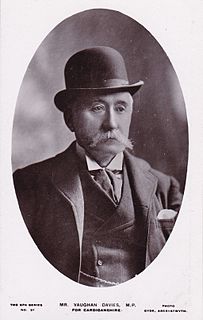
Matthew Lewis Vaughan-Davies, 1st Baron Ystwyth was a Welsh Liberal Party politician. He was Liberal MP for the Cardiganshire Division from 1895 until 1921.
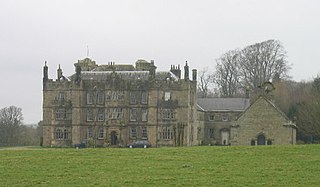
Chipchase Castle is a 17th-century Jacobean mansion incorporating a substantial 14th-century pele tower, which stands north of Hadrian's Wall, near Wark on Tyne, between Bellingham and Hexham in Northumberland, England. It is a Scheduled Ancient Monument and a Grade I listed building.

Welford Park is a country house and estate in the village of Welford in the English county of Berkshire, situated 5.2 miles northwest of Newbury and 10.9 miles south of Wantage. It is a Grade I-listed building.

Ripley Castle is a Grade I listed 14th-century country house in Ripley, North Yorkshire, England, 3 miles (4.8 km) north of Harrogate.
John Baird, DL, JP, was a Scottish Unionist politician.

Holme Hall is a grade II* listed 18th-century country house in Holme-on-Spalding-Moor, East Riding of Yorkshire, England. It was then a Sue Ryder Care Home until its closure in February 2018.

Falcondale is a hamlet in the community of Lampeter, Ceredigion, Wales, and occupies a low bluff overlooking the Nant Creuddyn north-west of Lampeter.
The fourth elections for Cardiganshire County Council took place in March 1898. They were preceded by the 1895 election and followed by the 1901 election
The sixth elections for Cardiganshire County Council took place in March 1907. They were preceded by the 1904 election and followed by the 1910 election
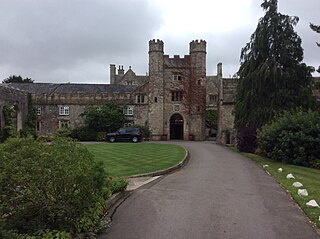
The Gatehouse and attached range, at the St Pierre Hotel, St Pierre, Mathern, Monmouthshire are the most significant remains of the mansion built by the Lewis family in the late 15th century and owned by them until 1924. The original house was built by William Lewis, and extended by his son George, between 1475 and 1508. After the Lewises sold up, the house had a variety of owners and was converted to the clubhouse of a golf club in 1962. It has since been massively extended as a hotel and country club. The gatehouse and range have Grade II* listed building status.
John Adams was a British politician who sat in the House of Commons between 1774 and 1780.

Pryse Loveden Pryse of Gogerddan, Cardiganshire and Buscot Park, Berkshire was a British Lord Lieutenant and Member of Parliament for Cardigan Boroughs from 1818 until his death in 1849.

Walter Lloyd, of Peterwell, Cardiganshire, was a British lawyer and Whig politician who sat in the House of Commons from 1734 to 1742.
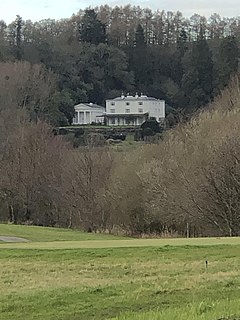
Glen Usk, Llanhennock, Monmouthshire is a country house dating from 1820. It was built for Sir Digby Mackworth, Bt. in the Neoclassical style. The house is Grade II* listed and the adjoining temple, and other associated structures, have their own Grade II listings.
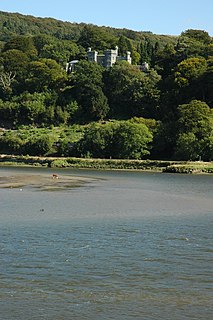
Glandyfi Castle in Glandyfi, Ceredigion, Wales, is a mock castle dating from the early 19th century. It was built for George Jeffreys, described by some as an evangelist, and by others as a barrister, circa 1819. His great-uncle, Edward, had purchased the estate in 1792. The architect is not known, although John Hiram Haycock has been suggested.